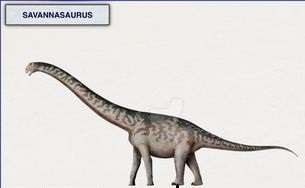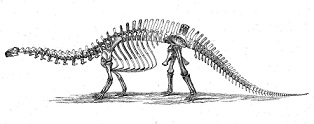
Savannasaurus, Dinosaur whose name aptly reflects its presumed habitat, is a genus of sauropod dinosaur that lived during the mid-Cretaceous period, approximately 95 million years ago. This colossal herbivore was a member of the sauropod group, known for their immense size and long necks. In this 500-word exploration, we will delve into the classification, physical characteristics, habitat, behavior, and significance of Savannasaurus in the world of paleontology.
Savannasaurus is classified as a sauropod dinosaur and is part of the titanosaur family, a diverse group of sauropods characterized by their massive size and unique features. The name Savannasaurus was given in reference to the savanna-like environment where its fossils were discovered.
The first fossils of Savannasaurus were discovered in Queensland, Australia, during the early 2000s. These fossil finds included partial skeletons, providing researchers with valuable information about this massive dinosaur.
| Name: | Savannasaurus dinosaurs |
| Size: | Around 12 to 15 meters in length. |
| Main Facts: | Savannasaurus is known for its bipedal stance, a rare trait among sauropod dinosaurs, shedding light on the diversity of these giants. |
Savannasaurus lived during the mid-Cretaceous period when Australia was part of the supercontinent Gondwana. Fossils of Savannasaurus have been found in Queensland, Australia, providing insights into the prehistoric environments of this region.
As a massive herbivore, Savannasaurus likely had a slow, lumbering gait. Its long neck allowed it to browse vegetation in treetops, and its teeth were adapted for stripping leaves from plants. It would have been a low-energy, bulk-feeding dinosaur, spending much of its time foraging for food.

Savannasaurus possessed several distinctive physical characteristics :
Savannasaurus was one of the largest dinosaurs of its time, with estimates suggesting it could reach lengths of up to 50 feet (15 meters) or more.
Like all sauropods, Savannasaurus had a long neck, a small head, a massive body, and a long tail. Its body was supported by four sturdy legs with column-like limbs.
It was a herbivore, using its long neck to reach vegetation high in trees and its peg-like teeth to strip leaves from plants.
Savannasaurus holds significance in the field of paleontology for several reasons :
It is one of several titanosaurs discovered in Australia, contributing to our understanding of sauropod diversity in this region during the Cretaceous.
As one of the few sauropod dinosaurs discovered in Australia, Savannasaurus provides crucial information about the ancient ecosystems and dinosaur fauna on this continent.
Savannasaurus helps researchers learn more about the distribution and evolution of dinosaurs within the ancient supercontinent of Gondwana, which included present-day Australia.
Savannasaurus was a gigantic sauropod dinosaur that lived during the mid-Cretaceous period, about 95 million years ago. It belonged to the titanosaur family and was known for its colossal size, possibly reaching lengths of over 50 feet (15 meters). Like all sauropods, it had a long neck, small head, massive body, and a long tail. Savannasaurus was a herbivore, using its long neck to reach vegetation high in trees.
Fossils of this dinosaur were found in Queensland, Australia, providing insights into the prehistoric ecosystems of the region and contributing to our understanding of sauropod diversity in Gondwana.
Savannasaurus belongs to the sauropod group, known for their massive size and long necks. Comparing it to other sauropods like Brachiosaurus or Apatosaurus highlights differences in size, body structure, and feeding habits.
While sauropods are generally large, Savannasaurus was relatively smaller, with an estimated length of 12-15 meters. In contrast, some sauropods reached lengths of 100 feet or more, emphasizing the diversity within this group.
Savannasaurus fossils were discovered in Australia, revealing its presence on the ancient supercontinent of Gondwana. This differs from sauropods like Diplodocus, which were found in North America.
Sauropods were herbivores with long necks for reaching vegetation. Savannasaurus likely had similar feeding habits but may have targeted different plant species compared to other sauropods, reflecting regional variations in flora.
Savannasaurus lived during the mid-Cretaceous period, approximately 95 million years ago. Comparing this timeframe to the existence of other sauropods, such as the Late Jurassic Brachiosaurus, illustrates the changing dinosaur diversity throughout Earth's history.
Some sauropods were quadrupedal, while Savannasaurus and a few others were bipedal. This distinction in locomotion indicates different evolutionary pathways within sauropods.
Detailed anatomical comparisons, including the shape of bones and teeth, help researchers understand the evolutionary relationships and adaptations of different sauropod species.